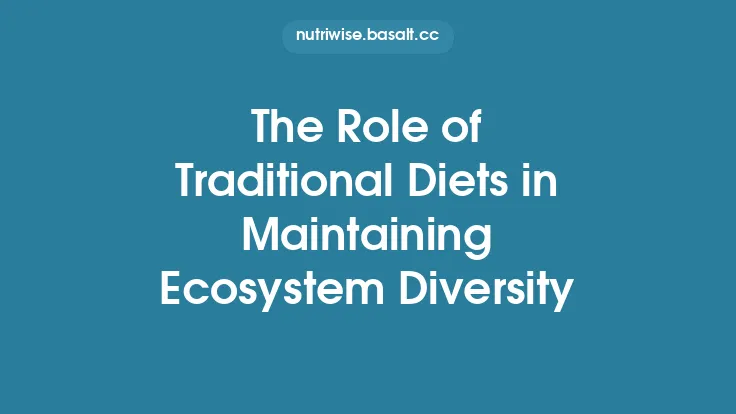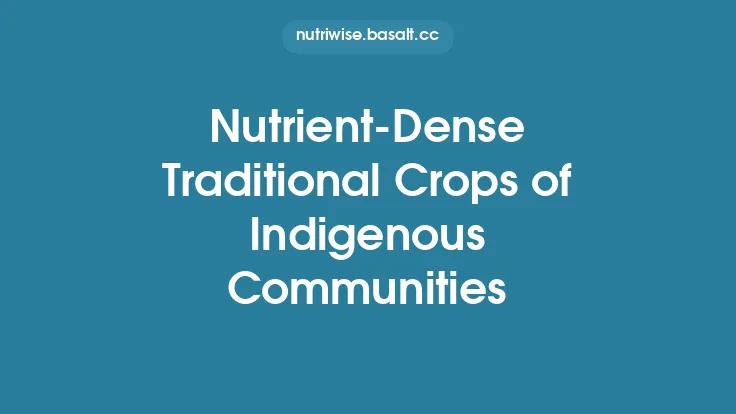Traditional Indigenous diets have sustained countless generations across the globe, offering a blueprint for health that extends far beyond the sum of individual nutrients. Rooted in centuries‑old relationships with land, water, and community, these eating patterns embody a holistic approach where physical vitality, mental clarity, emotional balance, and spiritual harmony are interwoven. By examining the underlying mechanisms that link traditional food practices to comprehensive well‑being, we can uncover timeless lessons that remain relevant for modern health challenges.
Physical Health Benefits
Balanced Macronutrient Profiles
Indigenous food systems typically emphasize a natural equilibrium of proteins, fats, and carbohydrates. Wild game, fish, and sustainably harvested shellfish provide high‑quality, complete proteins rich in essential amino acids, while simultaneously delivering omega‑3 fatty acids (EPA and DHA) that support cardiovascular health, reduce triglyceride levels, and modulate inflammatory pathways. Plant‑based components—such as tubers, wild greens, and nuts—contribute complex carbohydrates with low glycemic indices, promoting stable blood glucose and insulin sensitivity.
Micronutrient Synergy
The diversity of edible species in traditional diets supplies a broad spectrum of vitamins (A, C, D, E, K) and minerals (iron, zinc, calcium, magnesium, selenium). Unlike modern monocultures, these diets avoid nutrient gaps because each food group complements the others. For instance, the vitamin C found in wild berries enhances non‑heme iron absorption from leafy greens, while the calcium in certain aquatic plants works synergistically with vitamin D obtained from sun‑exposed fish oils to support bone mineralization.
Anti‑Inflammatory and Antioxidant Effects
Many indigenous foods are rich in phytochemicals—flavonoids, anthocyanins, carotenoids, and polyphenols—that act as potent antioxidants. Regular consumption of these compounds mitigates oxidative stress, a key driver of chronic diseases such as atherosclerosis, type‑2 diabetes, and certain cancers. Moreover, the omega‑3 fatty acids prevalent in marine and freshwater species down‑regulate pro‑inflammatory cytokines (e.g., IL‑6, TNF‑α), fostering a systemic environment conducive to tissue repair and immune resilience.
Metabolic Flexibility
Traditional diets often incorporate periods of fasting or reduced caloric intake aligned with seasonal availability. This intermittent caloric modulation trains the body’s metabolic pathways to efficiently switch between glucose and fatty acid oxidation, enhancing mitochondrial function and promoting autophagy—a cellular housekeeping process linked to longevity and reduced risk of metabolic syndrome.
Mental and Emotional Well‑Being
Nutrient‑Brain Interactions
Omega‑3 fatty acids, B‑vitamins (especially B12, folate, and B6), and trace minerals like zinc and magnesium are critical for neurotransmitter synthesis and neuronal membrane integrity. Indigenous diets, by naturally providing these nutrients, support optimal production of serotonin, dopamine, and GABA, which regulate mood, cognition, and stress responses. Studies have shown that populations adhering to such diets exhibit lower prevalence of depression and anxiety disorders.
Rhythmic Eating and Circadian Alignment
Eating patterns synchronized with daylight cycles—common in many traditional societies—reinforce circadian rhythms. Consistent meal timing supports the suprachiasmatic nucleus, stabilizing hormone release (e.g., cortisol, melatonin) and improving sleep quality. Adequate sleep, in turn, enhances memory consolidation, emotional regulation, and overall mental acuity.
Sensory and Ritualistic Aspects
The act of gathering, preparing, and sharing food is imbued with sensory richness—aromas, textures, flavors—that stimulate the limbic system, the brain’s emotional hub. Rituals such as communal feasting, storytelling around meals, and ceremonial consumption of specific foods foster a sense of belonging and purpose, which are protective factors against loneliness and psychological distress.
Spiritual Connection and Cultural Identity
Food as a Sacred Medium
In many Indigenous worldviews, food is not merely sustenance but a conduit for spiritual exchange. Consuming foods harvested with reverence—often accompanied by prayers or gratitude ceremonies—reinforces a reciprocal relationship with the environment. This spiritual reciprocity nurtures a sense of stewardship and inner peace, contributing to holistic health.
Embodied Knowledge and Identity
Traditional dietary practices encode cultural narratives, ecological knowledge, and ancestral wisdom. Engaging with these practices affirms personal and collective identity, strengthening self‑esteem and cultural pride. Such psychosocial empowerment has measurable health benefits, including reduced stress biomarkers (e.g., cortisol) and improved immune function.
Community Resilience and Intergenerational Health
Social Cohesion Through Shared Meals
Communal preparation and consumption of food create regular opportunities for intergenerational interaction. Elders transmit culinary techniques, seasonal calendars, and health insights to younger members, fostering a continuum of knowledge that supports adaptive health behaviors across lifespans.
Collective Immunity
When a community collectively adheres to a diet rich in diverse, minimally processed foods, the overall health profile improves, reducing the burden of communicable and non‑communicable diseases. This “herd health” effect can be especially protective in remote or resource‑limited settings where access to modern medical care is constrained.
Synergistic Food Synergies and Bioactive Compounds
Food Pairing for Enhanced Bioavailability
Traditional cuisines often combine foods in ways that amplify nutrient absorption. For example, pairing fatty fish with vitamin‑C‑rich berries can increase the bioavailability of iron from plant sources while also providing antioxidant protection for the polyunsaturated fats. Such synergistic pairings are a hallmark of Indigenous culinary wisdom.
Fermentation and Enzymatic Activation
Many Indigenous cultures employ natural fermentation—using wild yeasts and lactic acid bacteria—to transform raw ingredients into probiotic‑rich foods (e.g., fermented tubers, fish sauces, sour milks). Fermentation not only extends shelf life but also breaks down antinutrients (e.g., phytic acid), liberating minerals and creating bioactive peptides with antihypertensive and immunomodulatory properties.
Traditional Food Preparation and Its Impact on Digestibility
Low‑Heat, Slow‑Cooking Techniques
Methods such as pit roasting, stone boiling, and steaming preserve heat‑sensitive nutrients while tenderizing fibrous plant tissues. Slow cooking also facilitates the breakdown of collagen in animal proteins, yielding gelatinous soups that are easier on the digestive tract and support gut mucosal health.
Use of Natural Soaking and Sprouting
Soaking seeds, nuts, and legumes before cooking initiates enzymatic processes that reduce lectins and tannins, compounds that can impede nutrient absorption. Sprouting further increases vitamin C, B‑vitamins, and antioxidant levels, delivering a more bioavailable nutrient package.
Gut Microbiome and Fermentation Traditions
Microbial Diversity Through Traditional Foods
The consumption of a wide array of fermented and fiber‑rich foods cultivates a diverse gut microbiota. Species such as *Lactobacillus, Bifidobacterium, and various Clostridia* thrive on the prebiotic fibers and fermented substrates, producing short‑chain fatty acids (SCFAs) like butyrate, acetate, and propionate. SCFAs serve as energy sources for colonocytes, reinforce gut barrier integrity, and modulate systemic inflammation.
Modulation of the Gut‑Brain Axis
A balanced microbiome influences the production of neuroactive metabolites (e.g., tryptophan derivatives, GABA) that communicate with the central nervous system via the vagus nerve. This gut‑brain signaling contributes to mood regulation, stress resilience, and cognitive performance—key components of holistic health.
Epigenetic and Lifespan Implications
Nutrient‑Driven Gene Expression
Bioactive compounds prevalent in Indigenous diets—such as polyphenols, omega‑3 fatty acids, and methyl donors (folate, choline)—can modify epigenetic marks (DNA methylation, histone acetylation). These modifications influence the expression of genes involved in inflammation, metabolism, and cellular repair, potentially reducing the risk of age‑related diseases.
Transgenerational Benefits
Epigenetic changes induced by diet can be transmitted across generations, meaning that the health advantages of a traditional diet may extend to descendants who adopt similar eating patterns. This intergenerational epigenetic inheritance underscores the long‑term public health value of preserving Indigenous dietary practices.
Practical Takeaways for Modern Lifestyles
- Embrace Whole, Unprocessed Foods – Prioritize foods that are minimally altered from their natural state, focusing on a variety of animal and plant sources.
- Incorporate Seasonal Eating – Align meals with seasonal availability to naturally vary nutrient intake and support circadian harmony.
- Adopt Traditional Preparation Methods – Experiment with low‑heat cooking, soaking, sprouting, and fermentation to enhance digestibility and nutrient bioavailability.
- Foster Community Meals – Share meals with family or community groups to replicate the social and emotional benefits inherent in Indigenous food traditions.
- Mindful Consumption – Approach eating with gratitude and awareness, recognizing the broader ecological and cultural connections of each bite.
- Balance Macronutrients – Aim for a natural ratio of proteins, healthy fats, and complex carbohydrates, mirroring the equilibrium found in many Indigenous diets.
- Support Gut Health – Include fermented foods and high‑fiber plant sources to nurture a diverse and resilient microbiome.
By integrating these principles, individuals can tap into the time‑tested health advantages of traditional Indigenous diets, cultivating a state of well‑being that honors the body, mind, spirit, and community alike.





